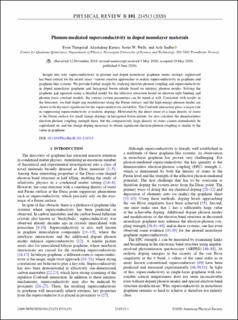| dc.contributor.author | Thingstad, Even | |
| dc.contributor.author | Kamra, Akashdeep | |
| dc.contributor.author | Wells, Justin | |
| dc.contributor.author | Sudbø, Asle | |
| dc.date.accessioned | 2020-09-14T08:21:22Z | |
| dc.date.available | 2020-09-14T08:21:22Z | |
| dc.date.created | 2020-06-10T08:40:21Z | |
| dc.date.issued | 2020 | |
| dc.identifier.citation | Physical review B (PRB). 2020, 101 (21) | en_US |
| dc.identifier.issn | 2469-9950 | |
| dc.identifier.uri | https://hdl.handle.net/11250/2677560 | |
| dc.description.abstract | Insight into why superconductivity in pristine and doped monolayer graphene seems strongly suppressed has been central for the recent years' various creative approaches to realize superconductivity in graphene and graphene-like systems. We provide further insight by studying electron-phonon coupling and superconductivity in doped monolayer graphene and hexagonal boron nitride based on intrinsic phonon modes. Solving the graphene gap equation using a detailed model for the effective attraction based on electron tight binding and phonon force constant models, the various system parameters can be tuned at will. Consistent with results in the literature, we find slight gap modulations along the Fermi surface, and the high-energy phonon modes are shown to be the most significant for the superconductivity instability. The Coulomb interaction plays a major role in suppressing superconductivity at realistic dopings. Motivated by the direct onset of a large density of states at the Fermi surface for small charge dopings in hexagonal boron nitride, we also calculate the dimensionless electron-phonon coupling strength there, but the comparatively large density of states cannot immediately be capitalized on, and the charge doping necessary to obtain significant electron-phonon coupling is similar to the value in graphene. | en_US |
| dc.language.iso | eng | en_US |
| dc.publisher | American Physical Society | en_US |
| dc.relation.uri | https://journals.aps.org/prb/pdf/10.1103/PhysRevB.101.214513 | |
| dc.title | Phonon-mediated superconductivity in doped monolayer materials | en_US |
| dc.type | Peer reviewed | en_US |
| dc.type | Journal article | en_US |
| dc.description.version | publishedVersion | en_US |
| dc.source.volume | 101 | en_US |
| dc.source.journal | Physical review B (PRB) | en_US |
| dc.source.issue | 21 | en_US |
| dc.identifier.doi | https://doi.org/10.1103/PhysRevB.101.214513 | |
| dc.identifier.cristin | 1814663 | |
| dc.relation.project | Norges forskningsråd: 250985 | en_US |
| dc.relation.project | Norges forskningsråd: 262633 | en_US |
| dc.description.localcode | The author or the author's employer may use all or part of the APS published article, including the APS-prepared version (e.g., the PDF from the online journal) without revision or modification, on the author's or employer's website as long as a fee is not charged. | en_US |
| cristin.ispublished | true | |
| cristin.fulltext | postprint | |
| cristin.qualitycode | 2 | |
